
However, the cumulative frequency graph is less familiar and is harder to interpret. The two graphs are related and actually contain the same information. The graph is sometimes called a cumulative frequency graph.Īn example of each graph is shown above. The total number of cases plotted against time.The graph is sometimes called a frequency graph. This information is usually shown as a histogram or needle plot. The following two graphs appear frequently: In this example, 2 observations were assigned to the 0-5 bin, 16 assigned to the 6-10 bin, 6 assigned to the 11-15 bin, 5 observations to the 16-20 bin and 2 observations to the 21-25 bin.During an outbreak of a disease, such as the coronavirus (COVID-19) pandemic, the media shows daily graphs that convey the spread of the disease. Select "Chart Output" to display the Histogram. Click OK.Select "Cumulative Percentage" to add a column that computes the cumulative number of observations and related percentages for each bin.Select "Pareto" to add a column listing the frequency values from greatest to least and the cumulative percentages of observations assigned to each bin.Keep "Labels" selected since the first row contains labels describing the contents of each column.Any records with values greater than 25 will be placed in the More bin. This range includes the upper bound of five (n) data "bins" or categories.


On the XLMiner Analysis ToolPak pane, click Histogram.The example below contains sales of Mark's Milk Chocolate Bars for the month of January for a small candy shop. A histogram uses bars (or rectangles) of different heights to display the frequency, or number of records, in the population. The Histogram tool creates individual and cumulative frequencies for a range of cells and specified number of bins.


 0 kommentar(er)
0 kommentar(er)
